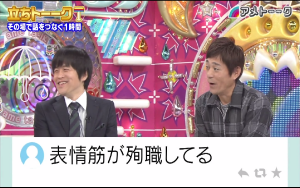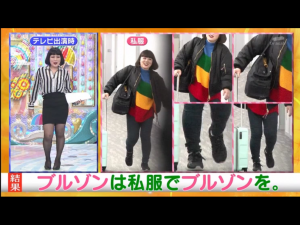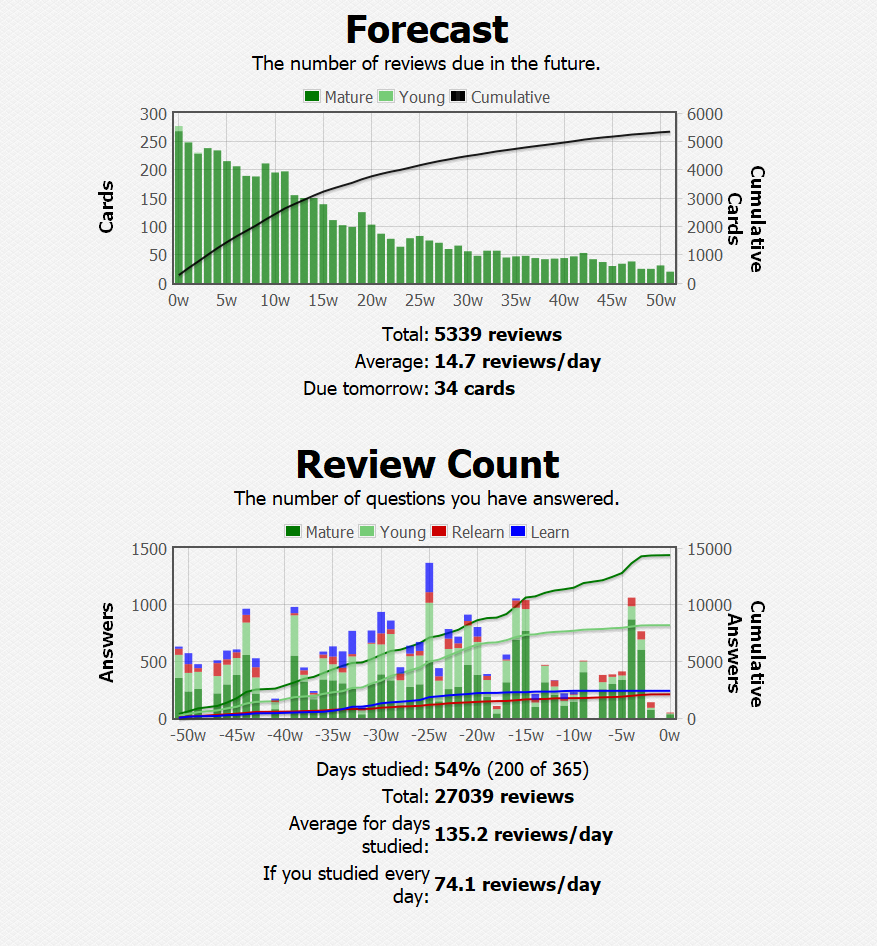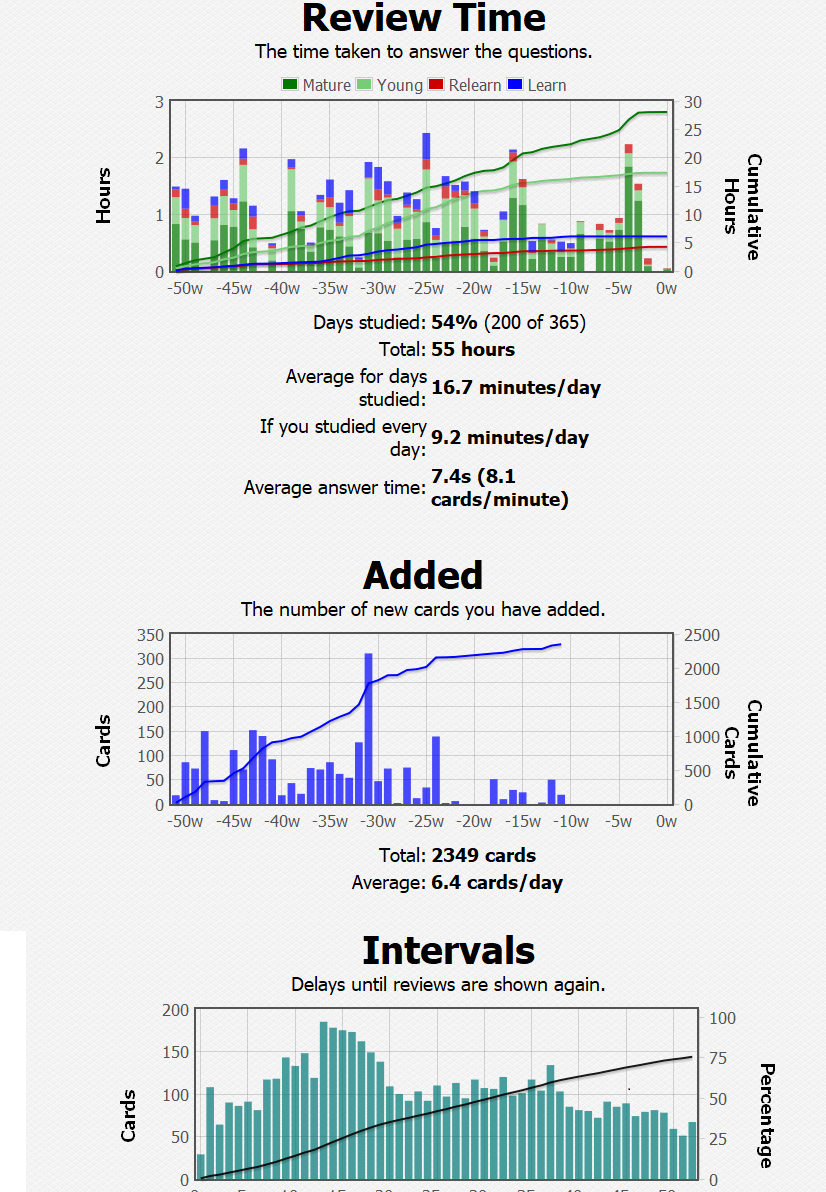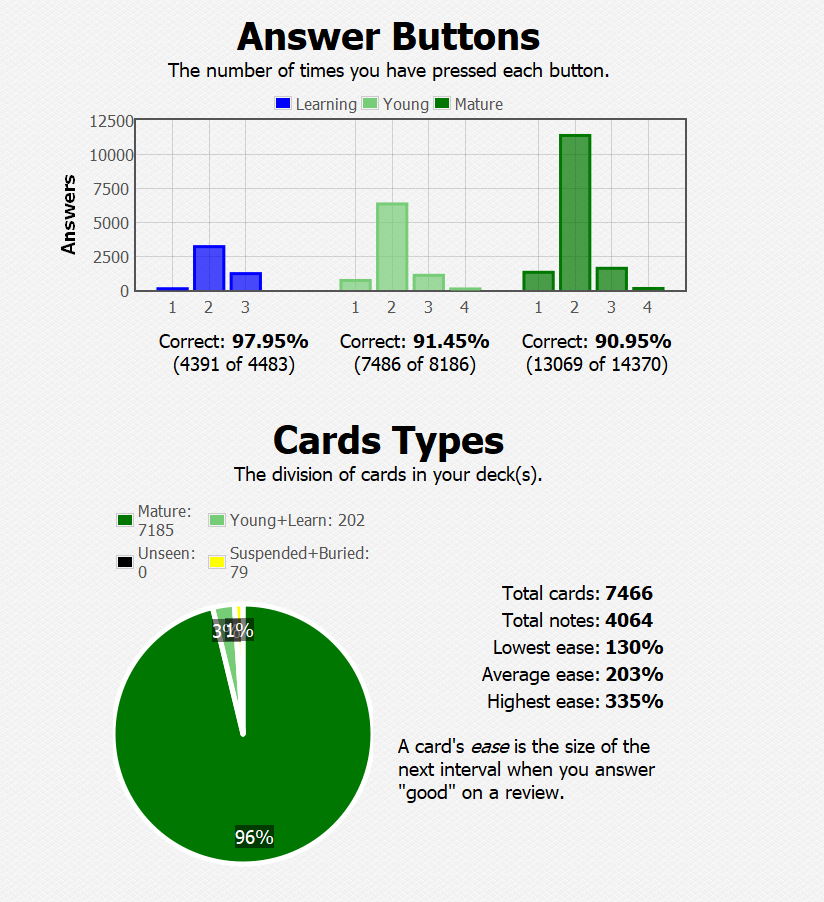mediafire links to c1-c2 autohotkey script && c3 autohotkeyscript && excel
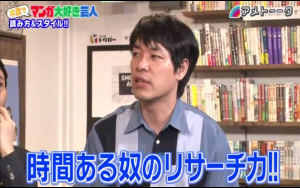 As you can see, I suck at showing up lol. It makes sense since I usually don’t do anki on most weekends (about 73 days when I do 52 x 0.7 x 2.. so there were 93 additional days that I didn’t do anki.. i musta been busy or didn’t feel like doing it) and I do reviews during dead time rather than part of a daily routine. They say you should use anki everyday for optimal results but I don’t completely agree with me at least for my case. I can say with confidence that half-assing anki does HELP and WORK. Of course since I don’t do reviews every day there are times where I have 500 reviews overdue. There have even been times where I was over a 1000 deep in overdue cards. However, this doesn’t freak me out since I have huge intervals so even if I chip at it slowly I eventually catch up because it’s not like the cards that I press “good” on come back into the pile in a few days…. Because I exclusively use cloze cards and have at least 2 clozes per card the 1000 card is more like 500 cards… Not to mention if I remember the word despite the card being over due for however many days or weeks, that just goes to show that I have great memory lol and I can feel better about myself j/k. Sometimes anki underestimates me! Because I have huge intervals, most of the cards that intervals of at least weeks or months so it doesn’t make a big difference if I see it 9 weeks later as opposed to 7 weeks or 2 months and 3 weeks instead of 2 months. Most cards have intervals of weeks or months so catching up is not a big deal and I don’t fail cards left and right to the point of despair. As I mentioned in my huge holy grail anki card format post, I do not mark fail on all the cards I fail since it’s counterproductive. For one thing, all cards are NOT equal. Some cards/words are just more useful than others and it can take a while to figure out which cards/words are very useful. If I had guess, I’d say I fail 70-100% of failed cards during reviews depending on how I feel. For example, if I already failed 10 -15 cards, I will feel less inclined to fail failed cards since I know I won’t want to deal with more than 15-20 cards 3 days (my step for lapsed cards) from when I failed them. Also if I skip anki for several days I may end up dealing with 40 failed cards from the 2 previous anki sessions in a review session so I keep that in mind too. I usually choose HARD for failed cards that I don’t want to fail (I’d rather deal with it x weeks/months from now rather than now) but sometimes I choose GOOD if the interval for GOOD is more ideal. Sometimes it’s better to deal with those cards LATER than right away since there is the off-chance that I will learn the word effortlessly from watching Korean TV. One recent example is 사재기 . At that time it was just another unknown word in a rap song from show me the money or high school rapper (it clearly wasn’t in the chorus lol.. i love the repetition in korean hip-hop/rap in the chorus/hook/etc especially when it features words I don’t know so that I can remember them effortlessly).
As you can see, I suck at showing up lol. It makes sense since I usually don’t do anki on most weekends (about 73 days when I do 52 x 0.7 x 2.. so there were 93 additional days that I didn’t do anki.. i musta been busy or didn’t feel like doing it) and I do reviews during dead time rather than part of a daily routine. They say you should use anki everyday for optimal results but I don’t completely agree with me at least for my case. I can say with confidence that half-assing anki does HELP and WORK. Of course since I don’t do reviews every day there are times where I have 500 reviews overdue. There have even been times where I was over a 1000 deep in overdue cards. However, this doesn’t freak me out since I have huge intervals so even if I chip at it slowly I eventually catch up because it’s not like the cards that I press “good” on come back into the pile in a few days…. Because I exclusively use cloze cards and have at least 2 clozes per card the 1000 card is more like 500 cards… Not to mention if I remember the word despite the card being over due for however many days or weeks, that just goes to show that I have great memory lol and I can feel better about myself j/k. Sometimes anki underestimates me! Because I have huge intervals, most of the cards that intervals of at least weeks or months so it doesn’t make a big difference if I see it 9 weeks later as opposed to 7 weeks or 2 months and 3 weeks instead of 2 months. Most cards have intervals of weeks or months so catching up is not a big deal and I don’t fail cards left and right to the point of despair. As I mentioned in my huge holy grail anki card format post, I do not mark fail on all the cards I fail since it’s counterproductive. For one thing, all cards are NOT equal. Some cards/words are just more useful than others and it can take a while to figure out which cards/words are very useful. If I had guess, I’d say I fail 70-100% of failed cards during reviews depending on how I feel. For example, if I already failed 10 -15 cards, I will feel less inclined to fail failed cards since I know I won’t want to deal with more than 15-20 cards 3 days (my step for lapsed cards) from when I failed them. Also if I skip anki for several days I may end up dealing with 40 failed cards from the 2 previous anki sessions in a review session so I keep that in mind too. I usually choose HARD for failed cards that I don’t want to fail (I’d rather deal with it x weeks/months from now rather than now) but sometimes I choose GOOD if the interval for GOOD is more ideal. Sometimes it’s better to deal with those cards LATER than right away since there is the off-chance that I will learn the word effortlessly from watching Korean TV. One recent example is 사재기 . At that time it was just another unknown word in a rap song from show me the money or high school rapper (it clearly wasn’t in the chorus lol.. i love the repetition in korean hip-hop/rap in the chorus/hook/etc especially when it features words I don’t know so that I can remember them effortlessly).
It’s in anki in my usual cloze format but for some reason I have trouble with remembering the word and the meaning… the word just doesn’t sound like what it means to me for some reason. So I failed it a bunch of times but later on I ended up learning the word effortlessly from Korean NEWS since everyone is stocking up on food and masks with the Corona Virus panic. I saw it being used in the news and remembered the cloze cards in my anki and understood it free of manual dictionary look-ups. Of course I probably couldn’t have done that if the card wasn’t in anki in the clozed deletion format (some words are memorable so even if i don’t make an anki card for it,,, i still remember it months later while other words/definitions leave my memory the second i finish reading the definition in the dictionary. I can vouch for this with conviction from my experience anking all these years with the crappy default settings and my superior settings ). Even though I failed the card a bunch of times, the cloze deletion format enables me to gain vague familiarity with the meaning and the word so that when I am presented the word in native media in the specific context/usage I recognize it ( that it’s in my deck and the info itself usually) then make the connection effortlessly and strengthen my connection. So the next time I see the word in anki I will mark it easy and not suspend it since I want to practice easy active recall (I only suspend really easy words)!
same thing also happened with gijige = stretch. I think I don’t have a cloze card for this word. The cards (plural because there are duplicate cards) for this word are in basic format in the huge decks I made from importing stuff from various sources.
It’s obviously better to spend your time learning/remembering words in memorable context in native material than to mindlessly drill words using ridiculous steps in anki (even if it feels like it works, it usually implodes on itself a week or 2 or a month later). The memory bond you make from encountering the word in a native material is always going to be stronger and longer-lasting than the memory bond you make from drilling the word in anki using ridiculous steps. My goal is to enjoy Korean media as much as a native, and not doing my anki reviews as honestly as possible.
It shows that I haven’t added new cards recently but I did have 300 new, unseen cards at one point. It’s inevitable since I only see 14 new cards a day with my settings. hmm I might have temporarily lowered number of new cards to 9 or something… can’t remember. It worked out fine since settings enable me to figure out which cards are actually easy and actually hard. I can never tell with certainty until anki shows me the card x months or weeks later.
Besides how I feel, the retention rate dictates whether or not I am using anki optimally. The retention rate is the section with the buttons. You can download plugins to get true retention rate or retention rate for mature card and whatnot if you want more data! I personally don’t bother since I know anki works for me.
The ideal retention rate for language learning is 80-90%. If any more or less, you’re probably wasting time. For my I got 97.95% for learning cards, 91.45% for young cards, and 90.95% for mature cards. They’re all above 90% but I’m not going to modify my settings because the majority of my cards are cloze cards and I don’t fail every card I fail. So I’m just going to assume that due to those factors, my retention is rate is actually around 80-90%.
Regarding my holy grail cloze format, it still is my holy grail format. How else do I get 7.4 secs per card? I don’t make as much cards one at a time while watching Korean shows. Compared to before I make 95% less cards than before. If I look up 20 words on lingoes while watching a show, I will probably end up hand-making my cloze deletion card for maybe 1-2 of them. The reason is because I use morphman’s mass tagger feature and priority.db. https://massimmersionapproach.com/table-of-contents/anki/morphman/
 Probably out of the 20 words I look, I will probably send anywhere from 5-10 of them to a .txt file using authotkey and a gaming house so I can curate those cards into a deck. Then during reviews I mark cards that I want cloze versions of since korean has homonyms and i have duplicate cards on top of that. Also some cards have example sentences, some have English, some have Japanese so I gotta pick the cards out. As I’ve mentioned before, you can mass make clozes in excel so the cards I pull into a deck CAN BE converted into cloze format by changing note type. I suck at deleting and suspending anki cards sometimes but I am great at curating! Doing the same thing for Japanese of course though I have very little to look up while watching honestly compared to Korean.
Probably out of the 20 words I look, I will probably send anywhere from 5-10 of them to a .txt file using authotkey and a gaming house so I can curate those cards into a deck. Then during reviews I mark cards that I want cloze versions of since korean has homonyms and i have duplicate cards on top of that. Also some cards have example sentences, some have English, some have Japanese so I gotta pick the cards out. As I’ve mentioned before, you can mass make clozes in excel so the cards I pull into a deck CAN BE converted into cloze format by changing note type. I suck at deleting and suspending anki cards sometimes but I am great at curating! Doing the same thing for Japanese of course though I have very little to look up while watching honestly compared to Korean.
My glorious settings
These settings give me 4 days -AGAIN , 8 days – GOOD , and 11 days -EASY for new cards!
I think it’s 1 day for good and 4 days for easy and like 1 minute again for the default settings lol. As you can see the settings make a HUGE DIFFERENCE.
I’m very satisfied with my anki settings. The setting that I despise the most in the default anki settings is the steps. I love my 3900 for steps for new cards. I don’t do multiple steps because I like the FUZZ factor that anki imparts on cards that are in review (and out of steps) so that if you have 10 cards with the interval of 5 days they don’t all show up 5 days later (some are 4, some are 6 etc). The fuzz factor evens out anki reviews better than steps which are exact… The default anki settings for steps is asinine and insulting especially if you make your own cards one at a time!!! I try to import whenever applicable though. Isn’t the default steps like 1 10 .. wtf is that. who the hell has time for that!!! stop the madness! there’s way too much interesting, compelling stuff to read/listen/watch/etc. So if you do your first run through for let’s say 50 cards depending on your settings (show failed cards sprinkled in the reviews or after reviews or before reviews etc), anki will start showing you the same card 2 times because the 1 min or 10 min is up but that makes no damn sense and kills the flow.
The main reason why I’m okay with not doing anki every day is the fact that my intervals are huge. To me it makes sense to “push myself” with big interviews to weed out the cards that are actually hard rather than over-reviewing cards. The other reason I’m okay with huge intervals is that I am familiar with Korean since I already knew Japanese when I started and I’ve been learning it, albeit half-assedly, since summer 2011. If you still use the default anki settings even though it’s 8 years into learning a language, you either really suck at the language or you’re extremely contently learning a language at an inefficient and slow-steady pace or you’re unnecessarily wasting a lot of time on Anki. I have my 8-9 year history with Korean so using the default settings are OUT OF THE QUESTION. I have a propensity for remembering Korean from the experience and intuition that i cultivated over the years so more times than not shit will sound like what it means or it takes little effort to remember or relearn compared Thai or some language that I have ZERO FAMILIARITY with. I have to use huge intervals and lax settings to make anki useful for learning korean. The conservative, default settings are straight up useless!! Of course if you have no foundation in the language that you’re learning or you’re doing some pre-made deck, you probably can’t do huge intervals. However, at the same time you don’t know what intervals you can handle until you actually try it. In fact, I first entered these settings on a whim as an experiment, just to see how “bad” it’ll be with not remembering anything but I ended up weeding out the “hard” cards and not wasting time on easy cards. Of course I failed more cards (it wasn’t a drastic increase) with the newer lax settings compared to my original lax settings but overall I end up saving time with the laxer settings since I can efficiently identify troublesome cards and easy cards (sometimes you just don’t know if a card is easy or tricky until anki tests ya x days or weeks later). For example with my original lax settings I might press good on a “hard” card 2 OR 3 times then fail it on the 3rd view and with my laxer settings I end up pressing good on a “hard” card once then fail it on the 2nd review. For easy cards, I would press easy on an “easy” card on my original lax settings 2-3 times in the same time span it would take for me to press “easy” once on laxer settings. Another boon of huge intervals is that it helps me notice how much better it is to learn a language with anki versus NO anki. It’s so much easier to notice how much I would’ve never remembered or retained by ONLY looking up a word in a dictionary and not addING it to anki since there’s no guarantee I will come across the word again in a convenient time span in native material. The settings are definitely are hitting a sweet spot in which I’m shown the card sometime right before the memory is completely obliterated from my brain lol( I pretty much never experienced this with the default settings lol) . I can say with overwhelming, beaming confidence that I learned/retained/re-learned WAY MORE KOREAN this past year with ANKI versus if I had done the exact same things I did with KOREAN with no anki. Not bad for only doing anki 200/365 days = 54.8% of the year especially because it said I averaged 16.7 min/day (I shudder and gasp when I hear horror stories of people spending wayyyyyyyyyy too much time on anki reviews for language learning). I had no idea I sucked at showing up this badly but it doesn’t make much of a difference since I can only tolerate anki with huge intervals. Space repetition for the win! As I’ve said many times, I have no idea why people use flash cards or notebooks (i especially roll my eyes and wince at the people using multiple colored pens to copy the dictionary and example sentence etc) for learning languages…
I cap the number of reviews at 40 and number of new cards at 14 because I like doing those number of cards especially since doing 14 new cards is like doing 7 easy new cards since they’re clozed cards. Any more just feels burdensome. However, I usually go back to the Korean deck multiple times to do 50 or 60 more reviews after doing other decks. Even if I tried to do 200 reviews in my korean deck, I know I will zone out after probably the 50th or 60th or 70th card so I don’t even put myself in that position. I use to lie to myself that I was paying attention after the 100th card etc but not anymore !! No point lying to yourself! I know what I can do and what I hate, so I work around that. Again, the conventional anki wisdom of completing all your reviews for the day does not work for me. It would just make me miserable, make anki time-consuming. Lastly, I don’t feel a tangible/noticeable benefit in my comprehension of Korean media when I keep on top of my anki reviews (as in getting the number of cards due for review down to zero and keeping it there) since I already understand korean tv well. I’m just learning words that natives know that I don’t know that aren’t common (ESPECially since I don’t watch/read Korean everyday since I have a damn life and enjoy my media in Japanese and English) but are still useful. I have NO aspirations of learning obscure Korean words that most native speakers don’t know unless there’s some special reason such as me possessing a keen interest in some niche field that most Koreans don’t have interest in (this has not happened to me yet!). I have my priorities straight which is that Korean media dictates what’s important and what I want to learn and remember rather than anki.
Anki said I did 27,039 reviews and I have 4064 cards. Of the 4064 notes, 2400 notes are new cards. To do some crude generalization and math, 27,039/4064 cards gives me 6.6 reviews per card over the year. Since I only do cloze format for Korean that 6.6 reviews feels more like 13.2 reviews ( I usually make 2 cloZes) so I’m that much more content. That sounds good and efficient to me and you sure as fuck can’t get that with flashcards that have no space repetition especially with 2400 cards. All it means is that I see the cards a bunch of times in increasing intervals over a long period of time which is what I want. I’m sure if I use the default settings my number of reviews would be triple or quadruple or even sextuple this number and I wouldn’t necessarily get better results and waste a shit ton of time and be anki’s bitch. This is one of the biggest reasons why I get irate when people try to compare anki with flash cards. They’re not in the same realm. They’re COMPLETELY DIFFERENT. STOP COMPARING THEM. I rolled my eyes when I read that someone decided to use quizlet instead of anki for aesthetic reasons… lol… talk about making an uninformed ecision. There’s a lot to customize for anki and nothing to customize for flash cards… even if we Were to talk about anki, depending on your settings and card type and plugins and how you use it and god knows what else since anki is so versatile, our experiences will be vastly different. The Anki experience varies greatly depending on HOW you use it and SET it up. Sure you can review a card with flashcards 13 times over a span of a week or a month but you probably won’t remember shit after a year or two since you’re not spacing the intervals. I have no idea why some people are so set on learning inefficiently with flashcards for languages of all things. and they’re usually learning 10 languages at once ORZ lol. My policy for learning Korean from the start has been what will make my vocab bigger 2/5 years from now not 1 week from now or 1 month from now because I know from experience how much better spaced repetition is compared to flash cards. PLus I’m kinda trying to make up for the time loss I experienced from using anki with the default settings for Japanese since I didn’t know better. I must mention that i don’t overburden myself with expectations because I’m not doing AKATT and I never intend to. My yearly goal for Korean has and always been to increase my passive vocab/comprehension as in “is my passive vocab/comprehension better than last year?.” the answer has always been an unequivocal yes!
Lastly it said I made almost 2400 cards but the number of notes is 1204. The number of notes is more important since I make multiple clozes. I found this out by searching card:1 added:365 in anki browse under the deck.
Felt like posting this since people sometimes obsess over using anki the most optimal way possible and end up spending way too much time on it. At the end of the day, anki is a supplement to language learning and half-ass anking still works ( It’s especially the case if you’re making your own cards and have a foundation with the language.). ANKI should not be some time-sucking vortex (making cards, editing cards, reviewing cards, fiddling with settings, fiddling with formatting/css etc, fiddling with plug-ins) ! I’d say if you’re using the default settings for language learning, it is precisely what I mentioned in the previous sentence. If the only way you can sustain anki reviews is by using the default settings, you’re probably better off doing other activities like reading and listening while putting your faith in natural SRS. Yes, some words repeat so often that you don’t even need to make anki cards for them….The default settings aren’t based on science and aren’t optimized for learning and all that jazz. Not to mention we’re all different which means we have different forgetting curves. The default settings are arbitrary! Most of all, they are OVERKILL
https://eshapard.github.io/anki/what-anki-learning-steps-to-use.html
